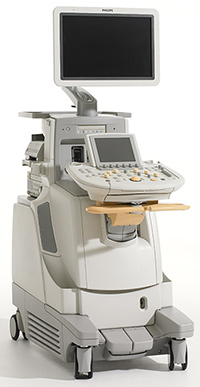How Ultrasound Imaging Works
Because ultrasound images are captured in real-time, they can show the structure and movement of the body’s internal organs, as well as blood flowing through blood vessels.
Ultrasound imaging is usually a painless medical test that helps physicians diagnose and treat medical conditions.
Conventional ultrasound displays the images in thin, flat sections of the body. Advancements in ultrasound technology include three-dimensional (3-D) ultrasound that formats the sound wave data into 3-D images.
A Doppler ultrasound study may be part of an ultrasound examination.
Doppler ultrasound is a special ultrasound technique that evaluates blood as it flows through a blood vessel, including the body’s major arteries and veins in the abdomen, arms, legs and neck.
Ultrasound examinations can help to diagnose a variety of conditions and to assess organ damage following illness. Ultrasound is used to help physicians diagnose symptoms such as:
- Pain
- Swelling
- Infection
Ultrasound is a useful way of examining many of the body’s internal organs, including but not limited to the:
- Heart and blood vessels, including the abdominal aorta and its major branches
- Liver
- Gallbladder
- Spleen
- Pancreas
- Kidneys
- Bladder
- Uterus, ovaries, and unborn child in pregnant patients
- Eyes
- Thyroid and parathyroid glands
- Scrotum (testicles)
- Joints – shoulder, wrist
Ultrasound is also used to:
- Guide procedures such as needle biopsies, in which needles are used to extract sample cells from an abnormal area for laboratory testing.
- Guide procedures such as steroid injections
Abdomen:
Nil by mouth 6 hours before examination. It may be easier to make a morning appointment and not have breakfast. This area includes organs such as Pancreas, aorta, liver gall bladder/ducts, kidneys, spleen, iliac fossa regions)
Renal and male pelvic:
Nil by mouth 4 hours prior. Empty bladder 1.5 hours before. Drink one litre one hour before appointment. Come in with full bladder. This area includes the bladder, prostate, and renal.
Female pelvic:
Empty bladder 1.5 hours before examination. Finish 1 litre of water 1 hour before to have full bladder. You will be able to use the bathroom half way through the procedure. This area includes reproductive organs e.g. uterus, ovaries and also the bladder.
Obstetric:
Empty bladder 1.5 hours before. Finish 1 litre of water 1 hour before to have a full bladder. You will be able to go to the toilet halfway through the procedure.
Ultrasound imaging is based on the same principles involved in the sonar used by bats, ships and fishermen. When a sound wave strikes an object, it bounces backward, or echoes. By measuring these echo waves it is possible to determine how far away the object is and its size, shape, consistency (whether the object is solid, filled with fluid, or both) and uniformity.
In medicine, ultrasound is used to detect changes in appearance and function of organs, tissues, or abnormal masses, such as tumours.
In an ultrasound examination, a transducer both sends the sound waves and records the echoing waves. When the transducer is pressed against the skin, it directs a stream of inaudible, high-frequency sound waves into the body. As the sound waves bounce off of internal organs, fluids and tissues, the sensitive microphone in the transducer records tiny changes in the sound’s pitch and direction. These signature waves are instantly measured and displayed by a computer, which in turn creates a real-time picture on the monitor. These live images are usually recorded on videotape and one or more frames of the moving pictures are typically captured as still images.
Doppler ultrasound, a special application of ultrasound, measures the direction and speed of blood cells as they move through vessels. The movement of blood cells causes a change in pitch of the reflected sound waves (Doppler effect). A computer collects and processes the sounds and creates graphs or pictures that represent the flow of blood through the blood vessels.
For most ultrasound exams, the patient is positioned lying face-up on an examination table that can be tilted or moved or on a chair.
A clear gel is applied to the area of the body being studied to help the transducer make secure contact with the body and eliminate air pockets between the transducer and the skin. The sonographer (ultrasound technologist) or radiologist then presses the transducer firmly against the skin and sweeps it back and forth over the area of interest.
Doppler sonography is performed using the same transducer.
When the examination is complete, the patient may be asked to dress and wait while the ultrasound images are reviewed. However, the sonographer or radiologist is often able to review the ultrasound images in real-time as they are acquired and the patient can be released immediately.
Most ultrasound examinations are completed within 30 minutes to an hour.
Most ultrasound examinations are painless, fast and easy.
After you are positioned on the examination table, the radiologist or sonographer will spread some warm gel on your skin and then press the transducer firmly against your body, moving it back and forth over the area of interest until the desired images are captured. There may be varying degrees of discomfort from pressure as the transducer is pressed against the area being examined.
If scanning is performed over an area of tenderness, you may feel pressure or minor pain from the procedure.
Ultrasound exams in which the transducer is attached to probe and inserted into an opening of the body may produce minimal discomfort.
If a Doppler ultrasound study is performed, you may actually hear pulse-like sounds that change in pitch as the blood flow is monitored and measured.
Once the imaging is complete, the gel will be wiped off your skin.
After an ultrasound exam, you should be able to resume your normal activities.
A radiologist, a physician specifically trained to supervise and interpret radiology examinations, will analyse the images and send a report to your primary care or referring physician, who will share the results with you.

